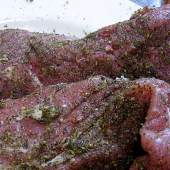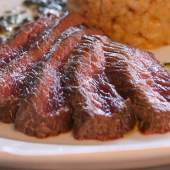A Q&A with Co-owners of Bar Pastoral – Greg O’Neill and Ken Miller

Hello everyone!
Are you ready to start the 16th season of Check, Please!? I am! This is an exciting season – jam-packed with more amazing finds recommended by all of you – as well as a few new elements. This season, right here on our website at wttw.com/checkplease, our guests will give confessional-style interviews before and after shooting their episode. How fun will this be to peek behind the curtains!
And, I hope you come here each week where I’ll showcase some of the fantastic chefs, restaurateurs, and beverage directors from our recommended spots. Have a burning culinary question for one of the chefs we’ve featured? Post it in the comments below!
This week, I spoke to Greg O’Neill and Ken Miller, co-owners of Bar Pastoral, about all things cheese. If you’re a curd nerd – keep reading…
Q. I get this question all the time…What is the proper way to store cheese?
A. This is a topic that you can really go deep on, but here are a couple of simplified rules to ensure your cheese stays in tip top shape. First and foremost, cheese needs to breathe. That means you need to wrap your cheese in special breathable cheese paper. At Pastoral we wrap the cheese in this special paper that we import from France. (It is also available for purchase from us.) Alternatively, wax or parchment paper can be good solutions. You can also store your chunk of cheese in a plastic container slightly larger than the size of the wedge. Do not wrap cheese in plastic if you can avoid it. This suffocates the cheese’s inherent flavor and the porous surface of the cheese will absorb the plastic-like flavor. The key is a tight seal so re-using the original plastic wrap on the cheese is definitely not recommended.
Q. Walk us through building a crowd-pleasing cheese tray.
A. There are several rules of thumb when crafting a cheese plate. Make sure you have a variety of milk types. Cow, goat, sheep, and water buffalo are the traditional animals for cheese production. Make sure you have a variety of textures – fresh and curdy, oozy soft ripened cheeses or washed rinds, semi firm cheeses with a bit of age, and hard aged cheeses. And bonus points for crystalline textures of aged goudas or alpines! There is such a thing as too many cheeses. Your palate can easily get overwhelmed, especially in an entertaining setting where there is a bevy of mixed drinks, wines, beers, and other beverages. Not to mention the other appetizers or courses in a meal! Keep your cheese selection streamlined to three to five differentiated selections because anything beyond that can be overkill. What it boils down to is variety and editing.
Cheese and accompaniments, Bar Pastoral
Q. What’s the best strategy for pairing wine with cheese?
A. Really the best strategy to pair wine with cheese is through trial and error. There are some go-to rules: pair acidic wines with fatty, full flavor cheeses, and try to match the impact on the palate. Dense, tannic wines go with robust aged cheeses; sweet wines with salty cheeses. A rule of thumb: what grows together goes together. However, there are no hard and fast rules, since every vintage of wine and each batch of cheese has its own nuances. What works on one occasion might not work with a different batch. This is part of what is so compelling about both of these agricultural but ever changing products. Wine and cheese keep you on your toes, so the best rule is to keep an open mind and experiment. My one pro tip is to never underestimate the power of bubbles when pairing with cheese. Sparkling wines help scrub your tongue and palate of the residual fat left behind by cheeses, and help to unlock layers of flavors in the cheese. Whether it is a soft and silky cheese or a dense and complex aged cheese, bubbles can be a pairing secret weapon.
Q: What are some can’t-miss, seasonal cheeses that people should try at Pastoral right now?
A: As we are moving into fall, we start to see a lot of the soft and seasonal sheep and goat milk cheeses dry off. This shift in the weather usually means the release of the previous summer’s Alpage cheeses. These special cheeses uphold the traditional practices and methods of ancient cheese-making, and are released in time for the holidays. Soon we will get our first batch of Alpage Gruyere AOC, as well as Vacherin Fribourgeois. Right now, we are celebrating American Cheese Month with a beautiful, buttery pecorino from Landmark Creamery in Wisconsin called Pecora Nocciola. Another new cheese we are featuring is the Cave Aged Chandoka aged at Standard Market Caves. This goat and cow mixed milk bandaged cheddar is creamy and complex, and the perfect snacking cheese.
Q. What are some notable accoutrements for cheese? And which go with what cheese?
A. When you have a great cheese we believe it can stand on its own. However, if you are looking to add complexity and intrigue to your cheese experience, there are lots of great options that can expand one’s horizons of what is possible. They can be savory or sweet. Aged balsamic or balsamic jelly with hard aged cheeses, such as parmigiano reggiano or pecorinos; single varietal honey with slightly pungent soft ripened goat cheeses or robiolas; dark chocolate with fudgy blue cheeses, such as stilton, bayley hazen, or bay blue; and our house roasted almonds with nutty alpine cheeses. Typical accompaniments include nuts, fruits (dried or fresh), jams, honeys, jellies and mostardas, pickled veggies, and of course, charcuterie, breads, and crackers. Like with pairings, there are no wrong or right answers, only rules of thumb, so experiment!
Cheese pairings, Bar Pastoral
Stay tuned next week for three more great restaurants and some more inside dish right here on my blog!
Cheers,
Catherine





